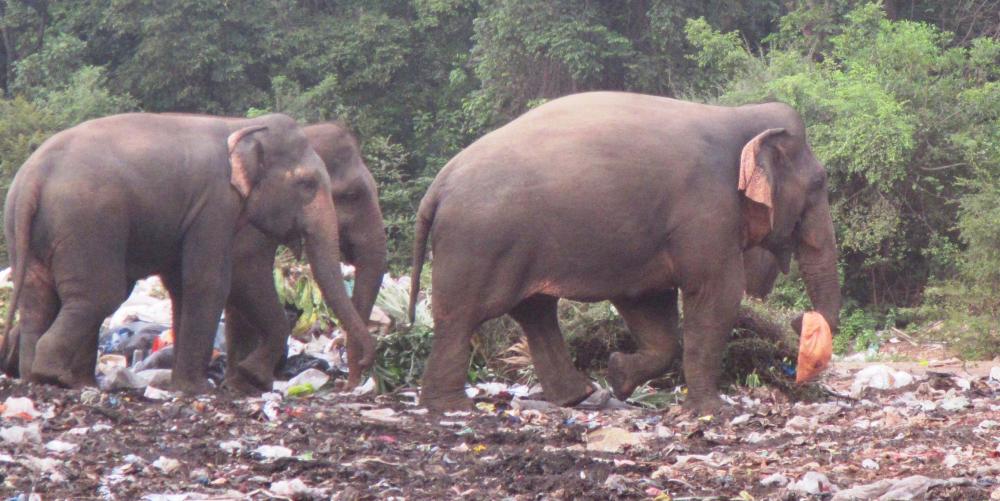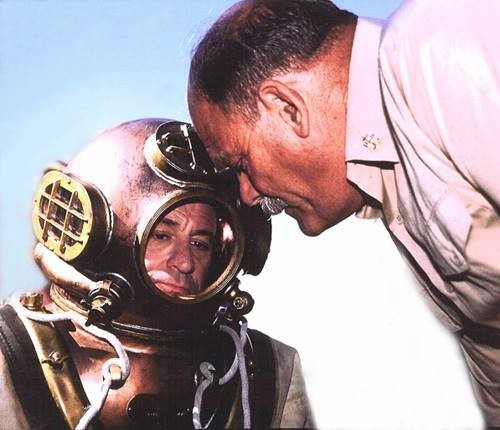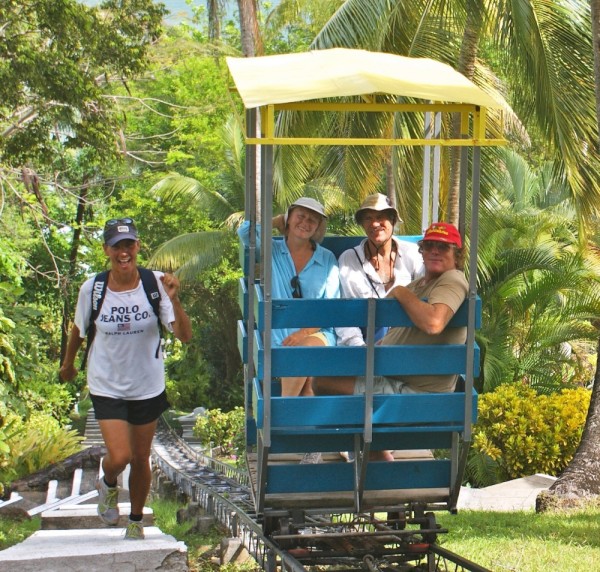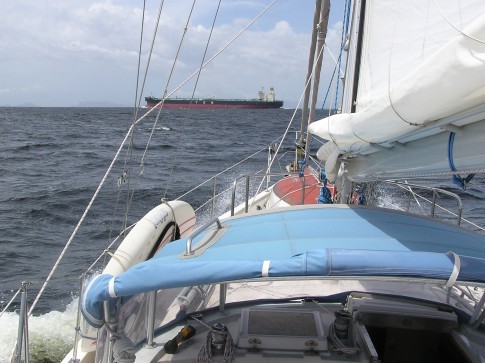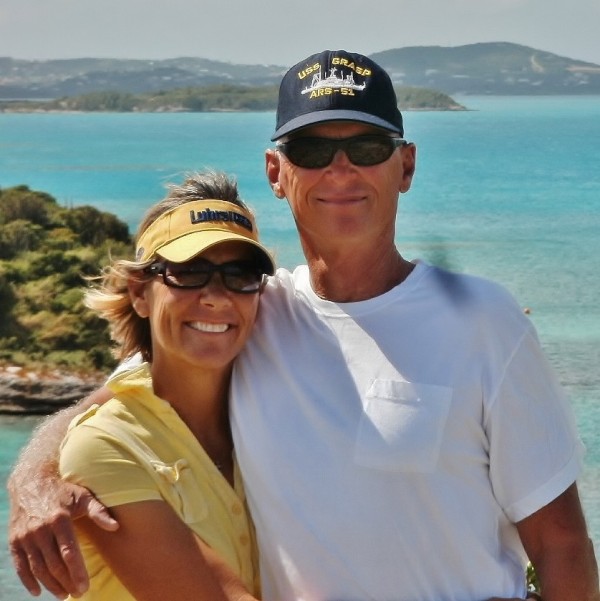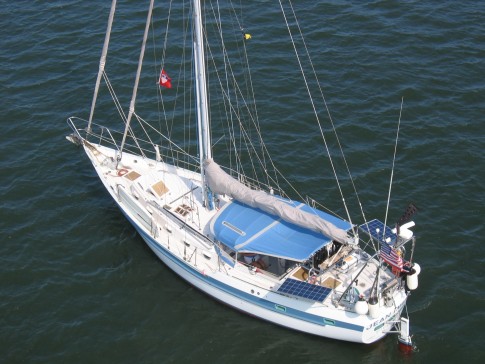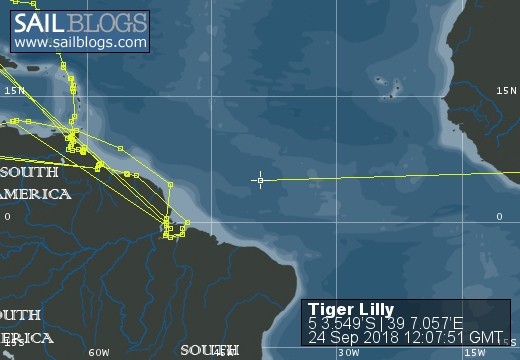
S/V Tiger Lilly
Rig heavy, reef early, and pray often; for God does not assure us an easy passage, but He does promise a safe anchorage...
25 May 2018 | TRINCOMALEE, SRI LANKA
02 January 2018 | Clan Jeti Anchorage, Georgetown, Penang Island, Malaysia
03 November 2016 | Singapore, Southeast Asia
02 October 2016 | Kumai River, Borneo
24 August 2016 | Rindja Island, Indonesia
22 July 2016 | Fannie Bay, Darwin, Northern Territory, Australia
14 June 2016 | Pancake Creek, Queensland, Australia
13 June 2016 | Pancake Creek, Queensland, Australia
11 June 2016 | Burnette Heads, Queensland, Australia
07 June 2016 | Mooloolaba, Queensland, Australia
11 May 2016 | Colmsie, Brisbane River, Queensland, Australia
23 December 2015 | Brisbane, Australia
13 August 2015 | Whangarei, New Zealand
07 August 2015 | Whangarei, New Zealand
23 July 2015 | Whangarei, New Zealand
12 April 2015 | Whangarei, New Zealand
11 February 2015 | Whangarei, New Zealand
25 January 2015 | Whangarei, New Zealand
24 September 2014 | BORA BORA, French Polynesia
23 September 2014 | Bora Bora
TIGER LILLY - FRENCH POLYNESIA
23 September 2014 | Bora Bora
Tom & Lilly
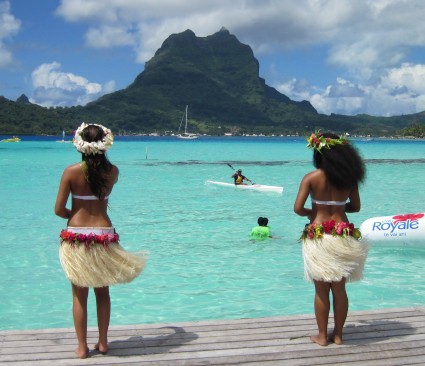
TROPICAL CYCLONE SEASON
Although our lives aboard a cruising sailboat may seem free and unrestricted, there are two stark realities which govern our lives aboard Spaceship TIGER LILLY: nature's Tropical Storm Season; and the Customs and Immigration laws imposed by man and his governments. In addition to the landsmen's inevitable "death and taxes" sailors have to avoid dangerous cyclones and too-often deal with recalcitrant self-important immigration officials! Life aboard a cruising sailboat can be very rewarding, but the practical realities of living afloat as a citizen of the world can be quite challenging too. However, for us, the benefits of cruising under sail far outweigh the difficulties. As we sip our morning coffee and watch the golden orb in the east peek over the dramatic cliffs of Bora Bora, green and proud as they thrust to the heavens in the soft early light, we are thankful for God's blessings and the opportunity to live free.
YACHT CLEARANCE
As we enter different countries we come under the specific Customs and Immigration laws of that country. In general, Customs regulations relate to things brought in or out of a country (such as our boat TIGER LILLY), and Immigration regulations relate to foreign people in a country (the crew, Tom and Lilly). We try to be responsible cruising sailors; we subscribe to a policy of leaving a clean wake. A major part of clean wake cruising is obeying the Customs and Immigration laws of each country we visit, but often that can be quite challenging. In most countries, tourists arriving by air usually complete a single simple short form, get a quick stamp in their passport, and off they go to convenient ground transportation and their hotel. For the crew of a cruising sailboat, the first day in a new and strange country is often a challenge. Our entry process often begins with finding a secure place to land our dinghy in an unfamiliar harbour. We then traipse about the city's port district - not usually the best part of town - map in hand, calling at such places as the Port Captain's Office, the Police Station, the Customs Office, the Immigration Office, and the Health Department. Signing antiquated forms declaring our vessel to be rat-free (Lilly sez: Now that's a stretch!), and further stating that the crew is louse-free and without communicable disease; all so that we can be issued an elaborate Certificate of Free Pratique. The bogus part of this whole situation is that, with very few exceptions, the Customs and Immigration officials never leave their air conditioned offices to actually inspect our vessel - it is all just a paperwork drill to shake us down for the fees. (We could have a giraffe, seven AK-47 automatic rifles, and a twenty pound bag of stolen Krugerrands aboard, and they would not have a clue - as long as the giraffe kept his head down.) Then we are off to the financial district to find a bank which accepts our American credit cards so we can obtain the local money to pay the required fees. More often than not the process is completed in a language other than English. By the time we are finished, Tom's hair hurts and he is looking for a sidewalk cafe to decompress with a cup of tea and a croissant, and Little Miss Sunshine wants to start exploring and making new friends ; and the dance continues.
CLEARANCE FEES
As cruising sailors ashore in a foreign country we have to formally enter the yacht into the host country's Customs system and regularly report our movements to Immigration. Often the fees and associated costs are significant; we even have a category in our budget for official fees. Lest we sound like smug Americans, the United States is well known throughout the international cruising fleet as having one of the most complex, bureaucratic, expensive, and least friendly Customs and Immigration systems in the world. In a people-government interaction not known for customer service, the good old USA Customs and Immigration Services ranks near the bottom. Many countries play tit-for-tat with a fee system structured to the traveler's country of origin. When we asked the Brazilian Immigration Officer why a visa for an American costs $180, while a European only pays $20, he pointed out that citizens of Brazil are charged $180 when they enter the United States; and a big "THANKS" goes out to the US Department of Homeland Security from TIGER LILLY for getting into our pocket! The good news is that we are in French Polynesia, and the French system is known for its simplicity and informality - a reflection on their philosophy of life and culture.
CRUISING CALENDAR
Our movements across the oceans of the world are governed by the natural forces of the Earth; in the tropics the easterly Trade Winds allow us to sail our boat westward during the winter sailing season, but hurricanes are a grave threat to those same latitudes during the summer months. We pay close attention to Tropical Storm Season, a hurricane (they call them tropical cyclones down here) is simply an unmanageable, extremely dangerous event likely to cost a sailor his boat - or possibly his life. We did not come to the cruising lifestyle to endanger ourselves or TIGER LILLY. For our safety, each year we honor the cruising sailor's axiom of leaving the active Cyclone Zone and heading up into the temperate latitudes during Tropical Storm Season. Our plan this year is to be in cyclone-free New Zealand during the Southern Hemisphere's 2014-2015 summer. What may appear to be an imposition actually adds variety to our sailing lifestyle - we alternate from beaches and palm trees to cities and civilization each year. After sailing nearly 8000 miles across the tropical South Pacific Ocean during this year's winter sailing season, we will be ready to slow down and give TIGER LILLY some of the TLC she deserves this coming summer in the safety of Polynesia's "Land of the Long White Cloud" - New Zealand.
ILES GAMBIER
This past June, after a 4000 mile 34 day passage direct from the Las Perlas Islands in the Gulf of Panama, we entered French Polynesia in the far south at Iles Gambier. Since there are no Customs or Immigration officials in that remote archipelago, we checked-in with the local Gendarmerie (French National Police). The process in this colonial outpost was actually quite simple; the friendly young police officer filled in a Customs Entry Form, we signed it, he stamped our passports, and then gave us a cup of French coffee - how civilized. Since the first port we would call at which had Customs and Immigration offices was Papeete, Tahiti, this initial process was considered a pre check-in, to be completed after we worked our way through the out-islands to the capital city. As directed by the written instructions given to us by the Gendarmerie, we mailed one copy of the check-in form to Customs and Immigration in Papeete, and hoisted the Quebec flag with our French national ensign on the starboard spreader arm. The yellow Quebec flag signifies that a vessel has not yet completed the entry process. The Gendarmerie sent an email to the Customs and Immigration offices in Papeete to let them know we were in the islands. There was no charge, and the Gendarmerie knew nothing of the French Polynesian Immigration Bond required to be paid by all non European Union citizens who arrive by yacht. Since there is no bank in the Iles Gambier (not even an ATM), there was no way to pay the bond there; however, we fully expected to pay it when we got to Papeete.
IMMIGRATION BOND
The French Polynesian Immigration Bond is a unique requirement established specifically for sailors coming to these beautiful South Pacific islands from the sea. During the 1960's and 1970's many free-loaders and bums from the drop-out generation found their way to French Polynesia aboard boats. After they checked-in they declared they were without funds and became wards of the French government; eligible for welfare payments and generous French social benefits. To prevent this unfortunate situation, an immigration bond equivalent to an airfare back to the crew member's country of record is required to be posted by the owner of the arriving yacht for each person aboard. Because France is a member of the European Union they are not allowed to impose this requirement on other citizens of the EU, but Americans are fair game. This refundable repatriation bond amounts to nearly $3000 USD in our case. (This is a convention which may not be familiar to Landsmen; the owners of a foreign yacht are legally responsible for any crew that the vessel brings into a country.) Since a tourist normally arrives by air with a return ticket, ensuring their departure prior to the expiration of their visa, they are not required to post a bond. The French Polynesian Bond requirement is just part of the reality of the lifestyle which we have chosen.
ILE HAO
After five weeks in the scenic Iles Gambier (anchorage 23-06.85S 134-57.98W) we didn't want to leave, but we had to get moving again; our visas only allowed us 90 days in French Polynesia, and we had a lot more islands to visit. Before we left Village Rikitea on Ile Mangareva we reported our departure to the Gendarmerie as required, and then set out on a 450 mile passage northwest into the Tuamotu Archipelago. At Ile Hao in the Tuamotus we checked-in with the Gendarmerie upon our arrival, he asked us for an estimate on how long we would stay, and then used that for a departure date - he did not seem at all concerned about our actual departure. For the first few days we were in an exposed anchorage off the town wharf (18.06.56S 140-54.54W), then we moved to the small port at the abandoned French Army base and moored TIGER LILLY alongside the wharf (18-05.96S 140-54.77W, depths in the teens in the approach, 12 feet alongside, and free of charge). While at Hao we availed ourselves to the excellent free medical and dental services provided to the islanders by the French government. Lilly had her left wrist examined and X-rayed (broken 3 months prior by a fall in Panama), Tom had a couple of old fillings replaced, and Lilly had her teeth cleaned - we certainly like the French system of universal health care. We offered to pay, and showed them our military ID cards as proof of medical insurance - but they had no way of collecting payment, and actually seemed amused at their American visitor's concern about cost. How refreshing and unusual - a medical system more interested in person's health rather than his money. Recently, we read on the Internet about the lame start which Obama Care has had back in the USA; we think that perhaps our country could learn something from the French regarding medical care.
TAHITI ITI
After leaving Ile Hao we sailed westward some 500 miles to the large island of Tahiti. Tahiti is actually two islands, Tahiti and Tahiti Iti (small Tahiti) joined by a narrow isthmus at Port Phaeton. Few cruisers call at Tahiti Iti, and we were eager to investigate this quiet rural island's south shore. We sailed through boisterous Passe Havae with huge breakers on each side of the pass to a sheltered and quiet anchorage at the Village of Teahupoo (17-51.05S 149-15.70). We came for two days, but stayed ten; it seems that each August the Billibong Pro World Surfing Championship is held at Passe Havae - the very place where the wave and the mountain meet - a famous logo. We just lucked into the "World Series" of international surfing, and what a fantastic experience it was. From Teahupoo we motored behind the reef in a well marked channel up to Port Phaeton. Unlike most of the developing countries we visit, the navigation aids in French colonies are absolutely first class, spot on, and can be trusted. Our first anchorage was off a boat yard and sailing club (17-43.96S 149-19.77W). Patrick, the sailing club President, welcomed us and said that we were free to land our dink, jerry jug water, and use their facilities. Our second anchorage in Port Phaeton was just off the rowing club in the back bay (17-43.84S 149-19.42W). This anchorage is quite convenient to a small mall which has a nice Carrefour Supermarket (with free Wi-Fi), a bank / ATM, and a few eateries.
MARINA TAINA
By the time we were ready to leave Port Phaeton it was the last week of August and the clock was ticking, both on our visas and the coming Cyclone Season; so we had to move along. We sailed outside and around Tahiti's fringing reef to Passe De Taapuna - and an easy entrance. We continued north behind the reef and anchored off the excellent dinghy dock at Marina Taina - a huge, modern, full service marina. The anchorage has hundreds of boats with lots of activity - we were no longer off the beaten path, but it was nice to see other cruisers whom we knew from Panama and the Caribbean. Marina Taina gave us access to Papeete, and they have a good fuel dock to take on duty-free fuel and potable water. We took the bus into Papeete and checked-in with Ken, the Yacht Master who is the Port Captain's representative to handle yacht clearances and zarpes. Ken's office is located in the center bay of the Ferry Terminal building on the Papeete waterfront.
PAPEETE CLEARANCE
Yacht Master Ken was very helpful and friendly as we completed the clearance formalities, but he would not answer questions regarding Customs or Immigration issues; apparently he got into trouble with the Immigration people in the past, so now he simply hands arriving yachties a paper with instructions regarding Customs and Immigration Requirements. The immigration section stated that if a yacht was arriving directly from a foreign port they must proceed to the Immigration Office at the Faa'a International Airport and check-in with the Immigration Officers - we were coming from Ile Hao, so that did not pertain to us. It further stated that if we were embarking or disembarking crew we had to go to the Immigration Office - that wasn't us either. When we asked Ken if he thought we should go to Immigration anyway (we were fully prepared and expecting to pay the bond), he said that we should read and follow the printed instructions - Ken (a Polynesian) obviously did not like the French Immigration folks. The second set of instructions dealt with Customs clearance. It stated that if we were arriving directly from a foreign country, or if we wanted to purchase duty-free fuel we had to proceed to Motu Uta (the commercial port district across the harbour) and present ourselves at the Customs Office. We did want duty-free fuel (it was a significant savings), so off we went to the Customs Office.
DUTY FREE FUEL
Maryetta, the lady at the Customs Office, was most helpful and friendly; getting a letter which authorized TIGER LILLY duty-free fuel was as easy as pie. The Pacific Puddle Jumper website (cruising magazine Latitude 38's informal South Pacific rally) led us to believe that we needed a ship's agent to get duty-free fuel - but we did it on our own in 5 minuets at the Customs Office (and saved an expensive agent's fee); Ken will give you a map, the Customs Office is about a 15 minute walk from his office. When we asked Maryetta (also a Polynesian) if she thought we should go to the Immigration Office at the airport, she made a face and said, "They are not nice people!" We showed her the paper Ken gave us, and she agreed that we did not fall into either category. Neither the Papeete Harbor Master's Yacht Master nor the French Customs Officer said anything about paying a bond, and both agreed that according to the Immigration Office's written instructions we did not need to go there. We had our clearance papers in-hand, and our passports had been stamped-in at Ile Gambier - so we gave the Immigration Office a pass. The final set of instructions that Ken gave us directed us to check-out with the local Gendarmerie if there was not a Customs or Immigration Office at our final island in French Polynesia; for us, that was Bora Bora. Apparently, the crew of TIGER LILLY had slipped through the bureaucracy, and we were not going to have to pay an immigration bond.
MOOREA
After just a few days in the crowded anchorage off Marina Taina, we sailed north out Passe Papeete and headed for the high green island of Moorea and its deep bays, just ten miles west of Tahiti. Part of the reality of cruising the South Pacific is anchoring in relatively deep water - 75 feet is not at all unusual, so bring lots of strong ground tackle. After an overnight at scenic Cooks Bay, we anchored to the west of Baie D'Opunohu (17-29.20S 149-52.66W) in a beautiful reef anchorage. The local hotel tour boats have trained a school of large sting rays to take food by hand at a sand bar just inside Passe Taotoi (17-29.25S 149-54.25W); the sand bar is just a 1.5 mile dinghy ride from the Papetoai reef anchorage. It was all quite fun feeding the sting rays canned sardines while a school of curious black tip reef sharks circle just a few meters away; admittedly schmultzy and touristy, but still way-kool! After our sting ray and shark experience we anchored in another reef anchorage to the east of the mouth of Baie D'Opunohu (12-29.50S 149-51.12W) off a park with a nice beach, picnic tables, trash bin, and a fresh water tap and shower. It was another crowded anchorage, but that is the norm for being back on the Milk Run cruising path. It was good to be around other cruisers again, but we had hoped to see them in smaller batches.
SOCIETY ISLANDS
From lovely Moorea, we took the usual path north through the Society Islands Leeward Group; anchoring overnight at Huahine and Tahaa in some pretty snotty blustery weather; the South Pacific Conversion Zone had moved east into the Society Islands. Our style / philosophy of cruising is to spend quality time in places so that we can get to know the local people a bit; but unfortunately, due to time constraints, we usually have to pass up a lot of nice places along the way. We understand that we cannot do it all; and as Tom's Naval Academy shipmates are fond of saying, "Time, tide, and formation wait for no man!" - so we were on the move and our destination was the enchanted island of Bora Bora.
BORA BORA
With steep green mountains, a deep blue lagoon, and a nearly continuous fringing reef laced with white surf, Bora Bora is perhaps one of the most beautiful islands in the world, and we wanted to spend some time here. We have a local friend Emmanuel who is the Principal at the VOTECH college and we enjoyed his warm hospitality and an interesting tour of the island. Bora Bora is a quiet place with a breathtaking natural beauty. This was the very place which inspired Navy Lieutenant Commander James Michner to write "Tales of the South Pacific" after returning from duty here during World War II. The follow-on musical "South Pacific" was based on that same book; - we enjoyed watching the 2001 version of the movie on our computer while we were here. We took anchorage at several places around the western lagoon: town anchorage off St. James Restaurant (Wi-Fi PW stjames1), convenient to the Super U supermarket and the Marine Services Chandlery (16-30.9S 151-45.2W); Maikai Marina, free moorings and spotty Wi-Fi, (16-30.4S 151-45.2W); west of Motu Toopua in a reef anchorage (16-30.9S 151-46.0W); Vaitape Village wharf, 12 feet alongside, free day mooring, water available at 2000 Francs (16-30.43S 151-45.15W); Pointe Raititi, Bloody Mary's Restaurant, free water available for patrons (16-31.7S 151-47.1W). We also enjoyed four anchorages in the less visited eastern lagoon: Matira Cove (16-32.5S 151-43.8W); Motu Piti UU Tai (16-32.3S 151-43.3W); Motu Piti Aau (16-32.3S 151-43.3W); and Motu Tupe (16-29.4S 151-42.1W). By following the well marked channels, we were able to get our 7 foot draft to all of these anchorages. High tide (less than a foot of tidal range) is usually around Local Apparent Noon. Although Bora Bora is a popular international tourist destination it is a laid-back kind of place, and a beautiful island to visit with a cruising sailboat - we hope you too will get a chance to see it one day.
FP CHECK-OUT
The check-out at the office of the Gendarmerie took all of 5 minutes, and we were checked-out of French Polynesia and cleared for Tonga. There is a nice Internet Cafe just across the street from Chin Lee Supermarket in Vaitape; the Wi-Fi is solid, and that is where we posted this blog. Before us is a ten day 1300 mile sail to the Kingdom of Tonga - see you there!
Although our lives aboard a cruising sailboat may seem free and unrestricted, there are two stark realities which govern our lives aboard Spaceship TIGER LILLY: nature's Tropical Storm Season; and the Customs and Immigration laws imposed by man and his governments. In addition to the landsmen's inevitable "death and taxes" sailors have to avoid dangerous cyclones and too-often deal with recalcitrant self-important immigration officials! Life aboard a cruising sailboat can be very rewarding, but the practical realities of living afloat as a citizen of the world can be quite challenging too. However, for us, the benefits of cruising under sail far outweigh the difficulties. As we sip our morning coffee and watch the golden orb in the east peek over the dramatic cliffs of Bora Bora, green and proud as they thrust to the heavens in the soft early light, we are thankful for God's blessings and the opportunity to live free.
YACHT CLEARANCE
As we enter different countries we come under the specific Customs and Immigration laws of that country. In general, Customs regulations relate to things brought in or out of a country (such as our boat TIGER LILLY), and Immigration regulations relate to foreign people in a country (the crew, Tom and Lilly). We try to be responsible cruising sailors; we subscribe to a policy of leaving a clean wake. A major part of clean wake cruising is obeying the Customs and Immigration laws of each country we visit, but often that can be quite challenging. In most countries, tourists arriving by air usually complete a single simple short form, get a quick stamp in their passport, and off they go to convenient ground transportation and their hotel. For the crew of a cruising sailboat, the first day in a new and strange country is often a challenge. Our entry process often begins with finding a secure place to land our dinghy in an unfamiliar harbour. We then traipse about the city's port district - not usually the best part of town - map in hand, calling at such places as the Port Captain's Office, the Police Station, the Customs Office, the Immigration Office, and the Health Department. Signing antiquated forms declaring our vessel to be rat-free (Lilly sez: Now that's a stretch!), and further stating that the crew is louse-free and without communicable disease; all so that we can be issued an elaborate Certificate of Free Pratique. The bogus part of this whole situation is that, with very few exceptions, the Customs and Immigration officials never leave their air conditioned offices to actually inspect our vessel - it is all just a paperwork drill to shake us down for the fees. (We could have a giraffe, seven AK-47 automatic rifles, and a twenty pound bag of stolen Krugerrands aboard, and they would not have a clue - as long as the giraffe kept his head down.) Then we are off to the financial district to find a bank which accepts our American credit cards so we can obtain the local money to pay the required fees. More often than not the process is completed in a language other than English. By the time we are finished, Tom's hair hurts and he is looking for a sidewalk cafe to decompress with a cup of tea and a croissant, and Little Miss Sunshine wants to start exploring and making new friends ; and the dance continues.
CLEARANCE FEES
As cruising sailors ashore in a foreign country we have to formally enter the yacht into the host country's Customs system and regularly report our movements to Immigration. Often the fees and associated costs are significant; we even have a category in our budget for official fees. Lest we sound like smug Americans, the United States is well known throughout the international cruising fleet as having one of the most complex, bureaucratic, expensive, and least friendly Customs and Immigration systems in the world. In a people-government interaction not known for customer service, the good old USA Customs and Immigration Services ranks near the bottom. Many countries play tit-for-tat with a fee system structured to the traveler's country of origin. When we asked the Brazilian Immigration Officer why a visa for an American costs $180, while a European only pays $20, he pointed out that citizens of Brazil are charged $180 when they enter the United States; and a big "THANKS" goes out to the US Department of Homeland Security from TIGER LILLY for getting into our pocket! The good news is that we are in French Polynesia, and the French system is known for its simplicity and informality - a reflection on their philosophy of life and culture.
CRUISING CALENDAR
Our movements across the oceans of the world are governed by the natural forces of the Earth; in the tropics the easterly Trade Winds allow us to sail our boat westward during the winter sailing season, but hurricanes are a grave threat to those same latitudes during the summer months. We pay close attention to Tropical Storm Season, a hurricane (they call them tropical cyclones down here) is simply an unmanageable, extremely dangerous event likely to cost a sailor his boat - or possibly his life. We did not come to the cruising lifestyle to endanger ourselves or TIGER LILLY. For our safety, each year we honor the cruising sailor's axiom of leaving the active Cyclone Zone and heading up into the temperate latitudes during Tropical Storm Season. Our plan this year is to be in cyclone-free New Zealand during the Southern Hemisphere's 2014-2015 summer. What may appear to be an imposition actually adds variety to our sailing lifestyle - we alternate from beaches and palm trees to cities and civilization each year. After sailing nearly 8000 miles across the tropical South Pacific Ocean during this year's winter sailing season, we will be ready to slow down and give TIGER LILLY some of the TLC she deserves this coming summer in the safety of Polynesia's "Land of the Long White Cloud" - New Zealand.
ILES GAMBIER
This past June, after a 4000 mile 34 day passage direct from the Las Perlas Islands in the Gulf of Panama, we entered French Polynesia in the far south at Iles Gambier. Since there are no Customs or Immigration officials in that remote archipelago, we checked-in with the local Gendarmerie (French National Police). The process in this colonial outpost was actually quite simple; the friendly young police officer filled in a Customs Entry Form, we signed it, he stamped our passports, and then gave us a cup of French coffee - how civilized. Since the first port we would call at which had Customs and Immigration offices was Papeete, Tahiti, this initial process was considered a pre check-in, to be completed after we worked our way through the out-islands to the capital city. As directed by the written instructions given to us by the Gendarmerie, we mailed one copy of the check-in form to Customs and Immigration in Papeete, and hoisted the Quebec flag with our French national ensign on the starboard spreader arm. The yellow Quebec flag signifies that a vessel has not yet completed the entry process. The Gendarmerie sent an email to the Customs and Immigration offices in Papeete to let them know we were in the islands. There was no charge, and the Gendarmerie knew nothing of the French Polynesian Immigration Bond required to be paid by all non European Union citizens who arrive by yacht. Since there is no bank in the Iles Gambier (not even an ATM), there was no way to pay the bond there; however, we fully expected to pay it when we got to Papeete.
IMMIGRATION BOND
The French Polynesian Immigration Bond is a unique requirement established specifically for sailors coming to these beautiful South Pacific islands from the sea. During the 1960's and 1970's many free-loaders and bums from the drop-out generation found their way to French Polynesia aboard boats. After they checked-in they declared they were without funds and became wards of the French government; eligible for welfare payments and generous French social benefits. To prevent this unfortunate situation, an immigration bond equivalent to an airfare back to the crew member's country of record is required to be posted by the owner of the arriving yacht for each person aboard. Because France is a member of the European Union they are not allowed to impose this requirement on other citizens of the EU, but Americans are fair game. This refundable repatriation bond amounts to nearly $3000 USD in our case. (This is a convention which may not be familiar to Landsmen; the owners of a foreign yacht are legally responsible for any crew that the vessel brings into a country.) Since a tourist normally arrives by air with a return ticket, ensuring their departure prior to the expiration of their visa, they are not required to post a bond. The French Polynesian Bond requirement is just part of the reality of the lifestyle which we have chosen.
ILE HAO
After five weeks in the scenic Iles Gambier (anchorage 23-06.85S 134-57.98W) we didn't want to leave, but we had to get moving again; our visas only allowed us 90 days in French Polynesia, and we had a lot more islands to visit. Before we left Village Rikitea on Ile Mangareva we reported our departure to the Gendarmerie as required, and then set out on a 450 mile passage northwest into the Tuamotu Archipelago. At Ile Hao in the Tuamotus we checked-in with the Gendarmerie upon our arrival, he asked us for an estimate on how long we would stay, and then used that for a departure date - he did not seem at all concerned about our actual departure. For the first few days we were in an exposed anchorage off the town wharf (18.06.56S 140-54.54W), then we moved to the small port at the abandoned French Army base and moored TIGER LILLY alongside the wharf (18-05.96S 140-54.77W, depths in the teens in the approach, 12 feet alongside, and free of charge). While at Hao we availed ourselves to the excellent free medical and dental services provided to the islanders by the French government. Lilly had her left wrist examined and X-rayed (broken 3 months prior by a fall in Panama), Tom had a couple of old fillings replaced, and Lilly had her teeth cleaned - we certainly like the French system of universal health care. We offered to pay, and showed them our military ID cards as proof of medical insurance - but they had no way of collecting payment, and actually seemed amused at their American visitor's concern about cost. How refreshing and unusual - a medical system more interested in person's health rather than his money. Recently, we read on the Internet about the lame start which Obama Care has had back in the USA; we think that perhaps our country could learn something from the French regarding medical care.
TAHITI ITI
After leaving Ile Hao we sailed westward some 500 miles to the large island of Tahiti. Tahiti is actually two islands, Tahiti and Tahiti Iti (small Tahiti) joined by a narrow isthmus at Port Phaeton. Few cruisers call at Tahiti Iti, and we were eager to investigate this quiet rural island's south shore. We sailed through boisterous Passe Havae with huge breakers on each side of the pass to a sheltered and quiet anchorage at the Village of Teahupoo (17-51.05S 149-15.70). We came for two days, but stayed ten; it seems that each August the Billibong Pro World Surfing Championship is held at Passe Havae - the very place where the wave and the mountain meet - a famous logo. We just lucked into the "World Series" of international surfing, and what a fantastic experience it was. From Teahupoo we motored behind the reef in a well marked channel up to Port Phaeton. Unlike most of the developing countries we visit, the navigation aids in French colonies are absolutely first class, spot on, and can be trusted. Our first anchorage was off a boat yard and sailing club (17-43.96S 149-19.77W). Patrick, the sailing club President, welcomed us and said that we were free to land our dink, jerry jug water, and use their facilities. Our second anchorage in Port Phaeton was just off the rowing club in the back bay (17-43.84S 149-19.42W). This anchorage is quite convenient to a small mall which has a nice Carrefour Supermarket (with free Wi-Fi), a bank / ATM, and a few eateries.
MARINA TAINA
By the time we were ready to leave Port Phaeton it was the last week of August and the clock was ticking, both on our visas and the coming Cyclone Season; so we had to move along. We sailed outside and around Tahiti's fringing reef to Passe De Taapuna - and an easy entrance. We continued north behind the reef and anchored off the excellent dinghy dock at Marina Taina - a huge, modern, full service marina. The anchorage has hundreds of boats with lots of activity - we were no longer off the beaten path, but it was nice to see other cruisers whom we knew from Panama and the Caribbean. Marina Taina gave us access to Papeete, and they have a good fuel dock to take on duty-free fuel and potable water. We took the bus into Papeete and checked-in with Ken, the Yacht Master who is the Port Captain's representative to handle yacht clearances and zarpes. Ken's office is located in the center bay of the Ferry Terminal building on the Papeete waterfront.
PAPEETE CLEARANCE
Yacht Master Ken was very helpful and friendly as we completed the clearance formalities, but he would not answer questions regarding Customs or Immigration issues; apparently he got into trouble with the Immigration people in the past, so now he simply hands arriving yachties a paper with instructions regarding Customs and Immigration Requirements. The immigration section stated that if a yacht was arriving directly from a foreign port they must proceed to the Immigration Office at the Faa'a International Airport and check-in with the Immigration Officers - we were coming from Ile Hao, so that did not pertain to us. It further stated that if we were embarking or disembarking crew we had to go to the Immigration Office - that wasn't us either. When we asked Ken if he thought we should go to Immigration anyway (we were fully prepared and expecting to pay the bond), he said that we should read and follow the printed instructions - Ken (a Polynesian) obviously did not like the French Immigration folks. The second set of instructions dealt with Customs clearance. It stated that if we were arriving directly from a foreign country, or if we wanted to purchase duty-free fuel we had to proceed to Motu Uta (the commercial port district across the harbour) and present ourselves at the Customs Office. We did want duty-free fuel (it was a significant savings), so off we went to the Customs Office.
DUTY FREE FUEL
Maryetta, the lady at the Customs Office, was most helpful and friendly; getting a letter which authorized TIGER LILLY duty-free fuel was as easy as pie. The Pacific Puddle Jumper website (cruising magazine Latitude 38's informal South Pacific rally) led us to believe that we needed a ship's agent to get duty-free fuel - but we did it on our own in 5 minuets at the Customs Office (and saved an expensive agent's fee); Ken will give you a map, the Customs Office is about a 15 minute walk from his office. When we asked Maryetta (also a Polynesian) if she thought we should go to the Immigration Office at the airport, she made a face and said, "They are not nice people!" We showed her the paper Ken gave us, and she agreed that we did not fall into either category. Neither the Papeete Harbor Master's Yacht Master nor the French Customs Officer said anything about paying a bond, and both agreed that according to the Immigration Office's written instructions we did not need to go there. We had our clearance papers in-hand, and our passports had been stamped-in at Ile Gambier - so we gave the Immigration Office a pass. The final set of instructions that Ken gave us directed us to check-out with the local Gendarmerie if there was not a Customs or Immigration Office at our final island in French Polynesia; for us, that was Bora Bora. Apparently, the crew of TIGER LILLY had slipped through the bureaucracy, and we were not going to have to pay an immigration bond.
MOOREA
After just a few days in the crowded anchorage off Marina Taina, we sailed north out Passe Papeete and headed for the high green island of Moorea and its deep bays, just ten miles west of Tahiti. Part of the reality of cruising the South Pacific is anchoring in relatively deep water - 75 feet is not at all unusual, so bring lots of strong ground tackle. After an overnight at scenic Cooks Bay, we anchored to the west of Baie D'Opunohu (17-29.20S 149-52.66W) in a beautiful reef anchorage. The local hotel tour boats have trained a school of large sting rays to take food by hand at a sand bar just inside Passe Taotoi (17-29.25S 149-54.25W); the sand bar is just a 1.5 mile dinghy ride from the Papetoai reef anchorage. It was all quite fun feeding the sting rays canned sardines while a school of curious black tip reef sharks circle just a few meters away; admittedly schmultzy and touristy, but still way-kool! After our sting ray and shark experience we anchored in another reef anchorage to the east of the mouth of Baie D'Opunohu (12-29.50S 149-51.12W) off a park with a nice beach, picnic tables, trash bin, and a fresh water tap and shower. It was another crowded anchorage, but that is the norm for being back on the Milk Run cruising path. It was good to be around other cruisers again, but we had hoped to see them in smaller batches.
SOCIETY ISLANDS
From lovely Moorea, we took the usual path north through the Society Islands Leeward Group; anchoring overnight at Huahine and Tahaa in some pretty snotty blustery weather; the South Pacific Conversion Zone had moved east into the Society Islands. Our style / philosophy of cruising is to spend quality time in places so that we can get to know the local people a bit; but unfortunately, due to time constraints, we usually have to pass up a lot of nice places along the way. We understand that we cannot do it all; and as Tom's Naval Academy shipmates are fond of saying, "Time, tide, and formation wait for no man!" - so we were on the move and our destination was the enchanted island of Bora Bora.
BORA BORA
With steep green mountains, a deep blue lagoon, and a nearly continuous fringing reef laced with white surf, Bora Bora is perhaps one of the most beautiful islands in the world, and we wanted to spend some time here. We have a local friend Emmanuel who is the Principal at the VOTECH college and we enjoyed his warm hospitality and an interesting tour of the island. Bora Bora is a quiet place with a breathtaking natural beauty. This was the very place which inspired Navy Lieutenant Commander James Michner to write "Tales of the South Pacific" after returning from duty here during World War II. The follow-on musical "South Pacific" was based on that same book; - we enjoyed watching the 2001 version of the movie on our computer while we were here. We took anchorage at several places around the western lagoon: town anchorage off St. James Restaurant (Wi-Fi PW stjames1), convenient to the Super U supermarket and the Marine Services Chandlery (16-30.9S 151-45.2W); Maikai Marina, free moorings and spotty Wi-Fi, (16-30.4S 151-45.2W); west of Motu Toopua in a reef anchorage (16-30.9S 151-46.0W); Vaitape Village wharf, 12 feet alongside, free day mooring, water available at 2000 Francs (16-30.43S 151-45.15W); Pointe Raititi, Bloody Mary's Restaurant, free water available for patrons (16-31.7S 151-47.1W). We also enjoyed four anchorages in the less visited eastern lagoon: Matira Cove (16-32.5S 151-43.8W); Motu Piti UU Tai (16-32.3S 151-43.3W); Motu Piti Aau (16-32.3S 151-43.3W); and Motu Tupe (16-29.4S 151-42.1W). By following the well marked channels, we were able to get our 7 foot draft to all of these anchorages. High tide (less than a foot of tidal range) is usually around Local Apparent Noon. Although Bora Bora is a popular international tourist destination it is a laid-back kind of place, and a beautiful island to visit with a cruising sailboat - we hope you too will get a chance to see it one day.
FP CHECK-OUT
The check-out at the office of the Gendarmerie took all of 5 minutes, and we were checked-out of French Polynesia and cleared for Tonga. There is a nice Internet Cafe just across the street from Chin Lee Supermarket in Vaitape; the Wi-Fi is solid, and that is where we posted this blog. Before us is a ten day 1300 mile sail to the Kingdom of Tonga - see you there!
Comments
| Vessel Name: | Tiger Lilly |
| Vessel Make/Model: | 1977 CSY44 walkover hull #55 |
| Hailing Port: | Green Cove Springs |
| Crew: | Lilly and Tom Service |
| About: | |
| Extra: | |
| Social: |
Tiger Lilly's Photos - Main
S/V Tiger Lilly
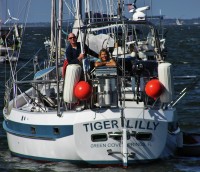
Who: Lilly and Tom Service
Port: Green Cove Springs

